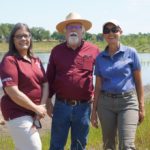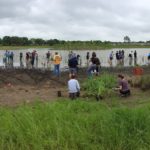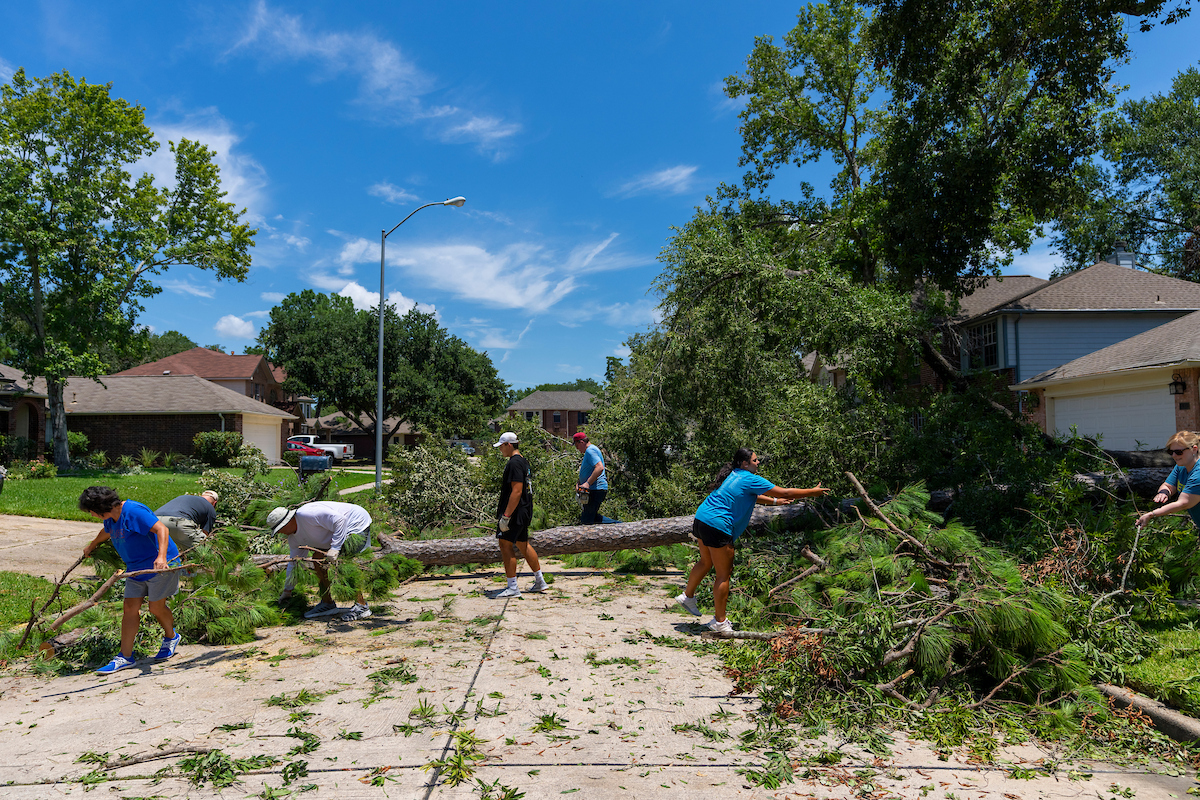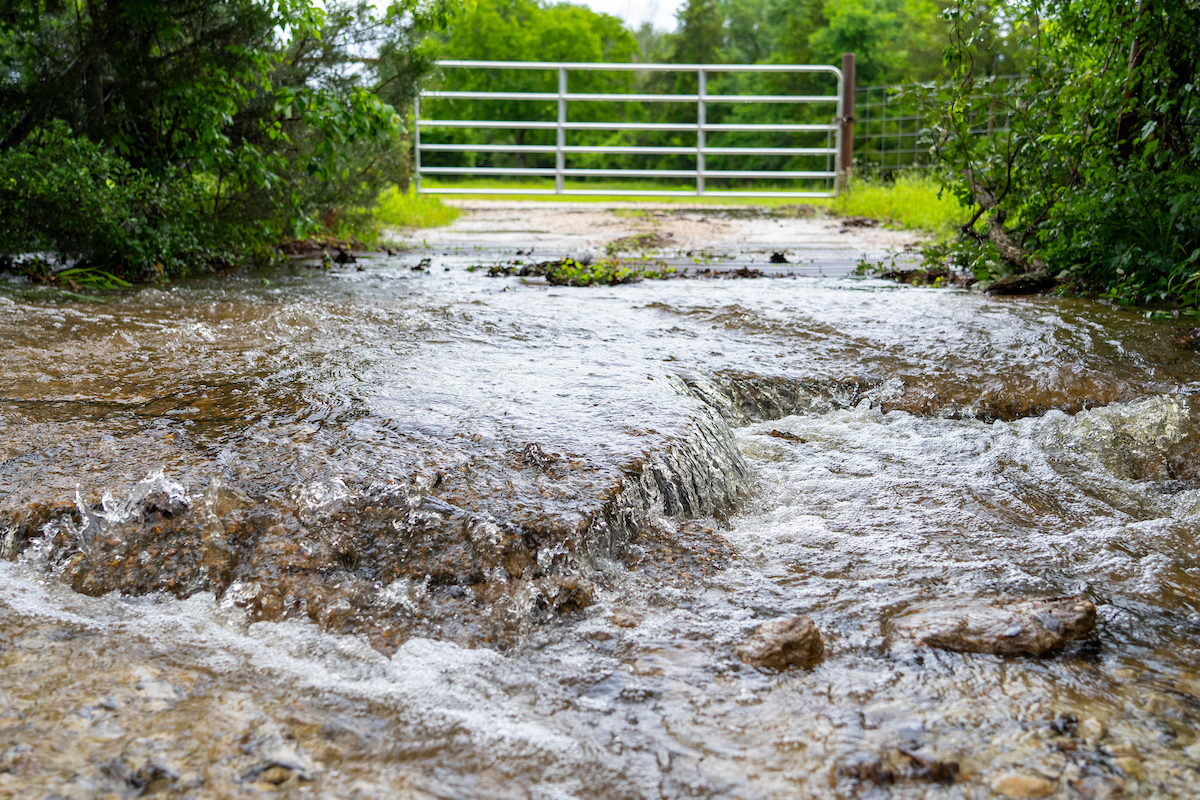Residents, AgriLife Extension, others work to ‘Harvey-proof’ Houston-area community
Effort leads to new Exploration Green nature park that will detain floodwater, clean runoff
Writer: Paul Schattenberg, 210-859-5752, [email protected]
Contact: Dr. John Jacob, 832-671-8171, [email protected]
Mary Carol Edwards, 281-989-5517, [email protected]
CLEAR LAKE – The Texas A&M AgriLife Extension Service, working in collaboration with area residents, the Clear Lake City Water Authority, or CLCWA, and Exploration Green Conservancy, have been collaborating to transform an about-to-be paved golf course into a new kind of nature park that provides recreation while protecting thousands of homes from flooding caused by natural disasters such as Hurricane Harvey.

“We were involved in an innovative overhaul of a slated-for-development golf course in Clear Lake City, helping repurpose it into a green space with water detention areas and places for recreational activities,” said Dr. John Jacob, AgriLife Extension specialist with the recreation, park and tourism sciences department of Texas A&M University.
Jacob, a Houston resident, lived in a neighborhood near the golf course when it was sold to a developer in the early 2000s.
“Area residents were very concerned about the possibility of additional flooding resulting from the new development, and they were also worried about increased runoff pollution,” Jacob said. “We participated in a push-back effort against the removal of a green space that virtually everyone in the area wanted to keep.”
The CLCWA eventually condemned the property for flood impact reduction and asked for residents’ input on other uses of the old golf course that would be compatible with floodwater detention. An oversight committee was formed and Jacob was named co-chair.
“We formed citizen committees to explore aspects such as athletic and ball fields, walking trails, native vegetation, stormwater wetlands and other possibilities,” Jacob said. “Local residents were intensely involved in this process and were diligent in exploring the many options for use of this green space. Their contributions formed the basis for a master plan developed by SWA Group Houston.”

He said the resulting plan was for a new nature park, Exploration Green, designed to detain and slow floodwaters and clean the runoff from 95 percent of the storms that occur in the area. Additional provisions were added for a walking trail, lake, wetlands areas and other features.
Jacob said the 178-acre golf course ran alongside large drainage ditches constructed by the original developer, providing a perfect setting for accommodating additional floodwater detention volume.
“Almost as soon as the master plan was completed there was additional resident participation. An Exploration Green conservancy was formed to oversee all facilities over and above floodwater detention,” he said. “The first phase of Exploration Green was about 80 percent completed when Hurricane Harvey hit and the detention area held enough stormwater runoff that even houses that habitually flooded with 5-inch to 10-inch storms didn’t flood with the 45 or so inches that came with Harvey.”
AgriLife Extension continued to participate by leading the way in the design and integration of stormwater wetlands into the overall plan, he said.

“The Texas Community Watershed Partners program of Texas A&M AgriLife was instrumental in this effort,” he said. “Texas Community Watershed Partners provides education and outreach to local governments and citizens on the impacts of land use on watershed health and water quality. It operates on the land-grant model of integrated university research, education and extension to help make Texas’ coastal communities more sustainable and resilient.”
Additionally, AgriLife Extension is participating in a statewide effort to help Texans recover from Hurricane Harvey. Last September, Gov. Greg Abbott asked Texas A&M University System Chancellor John Sharp to coordinate state and local recovery efforts of the Governor’s Commission to Rebuild Texas. Sharp then tasked employees of AgriLife Extension with serving as his local liaisons with the impacted communities, reporting on local recovery needs and providing a pipeline for information and recovery resources.
Dr. Monty Dozier, AgriLife Extension special assistant for Rebuild Texas, said the agency will continue to be involved in a variety of recovery efforts throughout the Rebuild Texas effort.
“AgriLife Extension personnel will continue to serve as liaisons between local jurisdictions and state and federal agencies in the most severely impacted counties,” he said. “And we will continue to help communities recover from Harvey and work to be more resilient for future events. Our involvement in the Exploration Green project will certainly help protect that community from flooding brought by future storms.”
Mary Carol Edwards, AgriLife Extension program specialist with Texas A&M’s Texas Community Watershed Partners, or TCWP, is a Houston native who grew up in the Clear Lake area and has been working on the stormwater wetlands portion of Exploration Green.
“This will be one of the largest stormwater wetlands initiatives ever undertaken by the TCWP, with nearly 40 acres of wetlands when all five phases of the initiative are completed,” she said.
According to the Clear Lake City Water Authority, the project’s five detention ponds are expected to help keep potentially 2,000 area homes from flooding through a collective water-holding capacity of a half-billion gallons, providing protection against a significant amount of rainfall and runoff.
Edwards also has been promoting the incorporation of constructed stormwater wetlands into urban drainage systems elsewhere along the Gulf Coast of Texas. Stormwater wetlands clean the stormwater that flows through them, including removing 99.99 percent of the nitrates that make their way into the runoff.
“Properly designed stormwater wetlands are beautiful and also attract a diversity of wildlife, including water and song birds,” she said.

For Exploration Green, Edwards develops planting plans and educational materials, leads a Texas Master Naturalist-based volunteer program, manages the wetland plant nursery and coordinates stormwater wetlands design and implementation with the Exploration Green Conservancy and other agencies involved in creating the park.
“Planting of the trees and wetlands in Phase 1 began in 2016, even while the detention pond was under construction,” she said. “As a result, about an acre of wetland is already approaching maturity and delighting visitors with displays of native water lilies and irises, and attracting wading birds and turtles.”
Edwards said an on-site wetland nursery supplies the aquatic plants for Exploration Green. The nursery has an approximately 30,000-plant capacity — enough to plant 5 acres at a time.
“During weekly workdays, plus special workdays for students, native plants are collected and propagated in the nursery,” she explained. “Over 300 volunteers assisted in the 2018 spring wetland planting events, which created 1.25 acres of new wetland. Over a dozen organizations, from the Girl Scouts of America to the NASA Sustainability group, have participated in this effort.”
A 1.1 mile concrete hike-and-bike trail loops the lake in Phase 1 and is proving to be popular with area residents, Edwards said. Each of the five phases will be connected by trails, providing approximately 6 miles of off-road recreational trails through a natural environment.
Water quality studies, funded by a grant from the Texas General Land Office Coastal Management Program, will begin in October 2018 to monitor and document water quality changes provided by the stormwater wetlands. A groundbreaking for Phase 2 of the stormwater wetlands portion of the project is slated for May 2018. All phases of the project are expected to be completed in 2022.
“This is a great example of residents, water management agencies, and others working together to save an important green space for recreation and to do so in such a way that it serves a vital environmental purpose that also helps improve the quality of life within that community,” Jacob said. “Other flood-prone communities in the metropolitan Houston area have shown interest in implementing this type of project, and we have also had inquiries from other states.”





